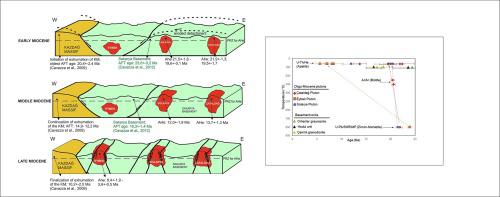Journal of Asian Earth Sciences ( IF 2.7 ) Pub Date : 2021-04-05 , DOI: 10.1016/j.jseaes.2021.104770 Şafak Altunkaynak , Alp Ünal , Gürsel Sunal , Ömer Kamacı , István Dunkl

|
In this study, we report the first robust apatite (U-Th)/He thermochronology data from the syn-extensional Eybek, Solarya and Çataldağ plutons from NW Turkey. The Solarya and Çataldağ plutons display similar (U-Th)/He apatite ages which range from 21.5 ± 1.6 to 12 ± 1.9 and 22.4 ± 1.2 to 13.7 ± 1.3 Ma, respectively. The Eybek Pluton, on the other hand, yielded younger (U-Th)/He apatite ages between 8.4 ± 1.9 Ma and 5.6 ± 0.5 Ma. Exhumation rates of the plutons change between 214 m/Myr and 122 m/Myr. The exhumation rates and thermal modelling results show that the Solarya and Çataldağ plutons experienced fast uplift and exhumation from early to middle Miocene. A low angle detachment fault(s) associated with Çataldağ Metamorphic Core Complex was responsible for the exhumation of the Çataldağ and Solarya plutons. In contrast, late Miocene cooling and exhumation of the Eybek Pluton was controlled by high angle normal faults. The collective evaluation of our data together with published low-temperature thermochronology data obtained from the spatially associated basement rocks and the metamorphic core complexes indicate that the region-wide exhumation of NW Anatolia was accommodated by different fault systems throughout the Miocene. We infer that the crustal exhumation in northwestern and centralwestern Anatolia occurred contemporaneously during the Miocene, and developed as a result of back-arc extension driven by slab roll-back beneath Hellenic arc and the preceding thermal weakening of the western Anatolian orogenic crust.
中文翻译:

西北安那托利亚(土耳其)的中新世隆升和发掘史:磷灰石(U-Th)/同伸型普尔腾的He热年代学的意义
在这项研究中,我们报道了来自西北土耳其的同延伸Eybek,Solarya和Çataldağp的第一个健壮的磷灰石(U-Th)/ He热年代学数据。Solarya和Çataldağ的Plutons表现出相似的(U-Th)/ He磷灰石年龄,分别为21.5±1.6至12±1.9和22.4±1.2至13.7±1.3 Ma。另一方面,Eybek Pluton产生的年轻(U-Th)/ He磷灰石年龄在8.4±1.9 Ma和5.6±0.5 Ma之间。lut的发掘速率在214 m / Myr和122 m / Myr之间变化。放化率和热模拟结果表明,从中新世早期到中新世,Solarya和Çataldağ体经历了快速的隆升和放化。与Çataldağ变质岩心复合体相关的低角度脱离断层导致了Çataldağ和Solarya岩体的掘出。相比之下,中新世晚期的冷却和Eybek Pluton的发掘受大角度正断层控制。对我们数据的集体评估以及从与空间相关的基底岩石和变质岩心复合体获得的已发布的低温热年代学数据表明,整个中新世不同构造的断层系统都容纳了西北安纳托利亚地区的掘出。我们推断,在中新世期间,安纳托利亚西北部和中西部的地壳发掘同时发生,并且是由于在希腊弧之下平板回滚和先前的西安纳托利亚造山壳热减弱而驱动的弧后伸展而形成的。对我们数据的集体评估以及从与空间相关的基底岩石和变质岩心复合体获得的已发布的低温热年代学数据表明,整个中新世不同构造的断层系统都容纳了西北安纳托利亚地区的掘出。我们推断,在中新世期间,安纳托利亚西北部和中西部的地壳发掘同时发生,并且是由于在希腊弧之下平板回滚和先前的西安纳托利亚造山壳热减弱而驱动的弧后伸展而形成的。对我们数据的集体评估以及从与空间相关的基底岩石和变质岩心复合体获得的已发布的低温热年代学数据表明,整个中新世不同构造的断层系统都容纳了西北安纳托利亚地区的掘出。我们推断,在中新世期间,安纳托利亚西北部和中西部的地壳发掘同时发生,并且是由于在希腊弧之下平板回滚和先前的西安纳托利亚造山壳热减弱而驱动的弧后伸展而形成的。











































 京公网安备 11010802027423号
京公网安备 11010802027423号